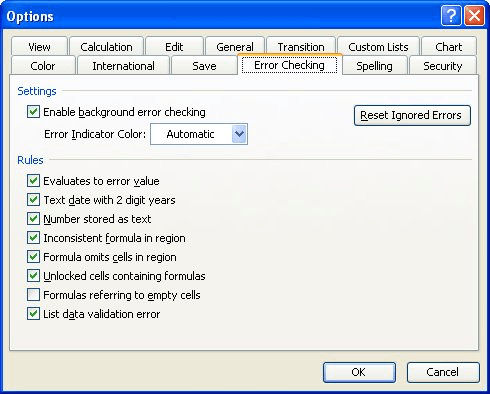Please Note: This article is written for users of the following Microsoft Excel versions: 2002 and 2003. If you are using a later version (Excel 2007 or later), this tip may not work for you. For a version of this tip written specifically for later versions of Excel, click here: Changing Error Checking Rules.
When Excel 2002 or Excel 2003 does background checking of your worksheet for errors, it follows a set number of rules. You can modify the rules that Excel follows through these steps:

Figure 1. The Error Checking tab of the Options dialog box.
ExcelTips is your source for cost-effective Microsoft Excel training. This tip (2370) applies to Microsoft Excel 2002 and 2003. You can find a version of this tip for the ribbon interface of Excel (Excel 2007 and later) here: Changing Error Checking Rules.

Create Custom Apps with VBA! Discover how to extend the capabilities of Office 365 applications with VBA programming. Written in clear terms and understandable language, the book includes systematic tutorials and contains both intermediate and advanced content for experienced VB developers. Designed to be comprehensive, the book addresses not just one Office application, but the entire Office suite. Check out Mastering VBA for Microsoft Office 365 today!
The two newest versions of Excel rely upon the Internet to grab help information. If you don't want Excel to seek help ...
Discover MoreIf you work in the sciences or mathematics, you know that significant digits are important. This tip answers questions ...
Discover MoreWant to use the maximum space possible for displaying information on screen? You'll want to learn how to use the ...
Discover MoreFREE SERVICE: Get tips like this every week in ExcelTips, a free productivity newsletter. Enter your address and click "Subscribe."
There are currently no comments for this tip. (Be the first to leave your comment—just use the simple form above!)
Got a version of Excel that uses the menu interface (Excel 97, Excel 2000, Excel 2002, or Excel 2003)? This site is for you! If you use a later version of Excel, visit our ExcelTips site focusing on the ribbon interface.
FREE SERVICE: Get tips like this every week in ExcelTips, a free productivity newsletter. Enter your address and click "Subscribe."
Copyright © 2025 Sharon Parq Associates, Inc.
Comments